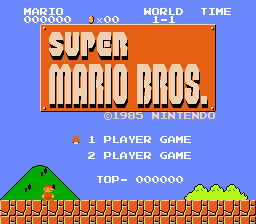Classic Games Emulation | News | Systems | Emulation | Emulators | Games | Links
The Nintendo Entertainment System
In 1985, Nintendo brought the Famicon to America under the name Nintendo Entertainment System. It was badly needed, as the market was still reeling from the video game crash of 1984. And the NES turned out to be exactly what the market wanted. With better graphics and new games - and kinds of games - the Nintendo achieved dominance quickly. Competitiors like the Sega Master System are practically forgotten. Video gaming in the second half of the eighties is veritably synonymous with Nintendo. It is credited with being the most successful game system yet, it's closest competitors being the venerable Atari 2600 and the Nintendo's portable cousin, the Gameboy.

One other important thing contributed to the Nintendo's success, which should not be overlooked. The short history of video games has shown that the systems which succeed are the ones with the best games. And the Nintendo had some of the best and most important video games of all time. After Mario's appearance in Donkey Kong, and then his appearance with Luigi in Mario Bros., he grabbed the starring role in the most recognized video game: Super Mario Bros. This rather odd and addicting game somehow managed to embed itself in video game history like no other.
Also along with the Nintendo came the concept of "the level." Players essentially had to memorize a level of a game before they could beat it. Beating Super Mario. Bros. the first time through would be rather difficult even for a great gamer, simply because he or she must know the level design to traverse the level successfully. This concept forever changed the face of video games, for good and bad. Video games lost much of their previous simplicity - and effectiveness - of gameplay, but games also became more robust and versatile, albeit at the cost of replay value (SMB is pretty much an exception though - I play that game as much as Asteroids...).
In the early nineties, Nintendo finally replaced the old NES with its new 16-bit Super Nintendo. But by then, Sega had released the Genesis, and so on, and Nintendo had lost some of its dominance, though much of its market share held. But the market was once again becoming diversified, and Nintendo no longer had complete control.
(Around the same time they released Tetris II, Nintendo released a redesigned
Nintendo. Instead of being a spring-loaded front-loader, it was a top-loading
machine like every other game machine available [any owner of an old Nintendo
will know why this was important - when the springs wear out, so does the Nintendo].)
![]()
The Nintendo Entertainment System
Classic Games on the Nintendo
NES Links
About CGE (including contact information)
Created March 28, 1998. Last updated June 7, 1998.